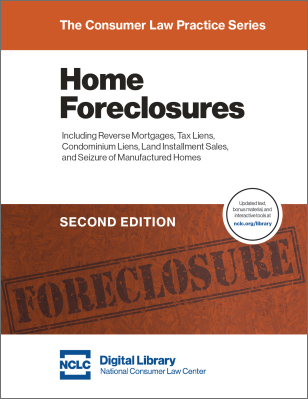On April 14, 2016 the Federal Housing Finance Agency (FHFA) announced what it described as its final loss mitigation initiative of the foreclosure crisis, a “Principal Reduction Modification Program.” The Program will apply to a limited number of loans owned or insured by Freddie Mac or Fannie Mae. Borrowers will not be able to apply for these modifications. Instead, during the latter half of 2016 FHFA and the servicers will generate offers to the borrowers they deem potentially eligible.
The new program follows a solicitation procedure similar to the mechanism the GSEs have used for their Streamlined Modification Program since 2013. For more on workout options for Fannie Mae and Freddie Mac loans, see NCLC’s Foreclosures and Mortgage Servicing § 5.11 (5th ed. 2014), updated online. These options are independent of the HAMP program, described at Foreclosures and Mortgage Servicing § 5.8, that at least for this year are still available for Fannie and Freddie Loans. See chapter 6 for loss mitigation programs for FHA, VA and RHS loans.
The New Principal Reduction Waterfall
The GSEs new Principal Reduction Modification Program employs a substantive modification waterfall with steps that closely resemble those for the GSEs’ Streamlined Modification. Rather than targeting an affordable payment, the Streamlined Modification applies cookie-cutter modification terms and relies on information already in the servicer’s possession. Borrowers do not submit income information to be used to fashion an affordable payment.
The Streamlined Modification capitalizes arrearages, applies the same interest rate uniformly in all cases, and extends the loan term to 40 years from the modification date. A Streamlined Modification allows for principal deferment or forbearance only in limited instances, generally to bring the modified principal balance to a level that is no more than 115% of the property’s current market value. The new Principal Reduction Modification Program replaces this final principal deferment step with principal forgiveness.
Eligibility Requirements
There are several specific eligibility requirements for the Principal Reduction Modification. First, this is a one-time offering: the borrower must have been at least 90 days in arrears as of March 1, 2016. Borrowers who reach the 90-day delinquency stage later will not be eligible. Second, the pre-capitalization unpaid principal balance of the loan must be less than $250,000. Third, the property must be underwater. Specifically, the current mark-to-market loan to value ratio (after capitalization) must be at least 115%. Borrowers who previously received a GSE loan modification are not eligible for a Principal Reduction Modification.
The Principal Reduction Process
Servicers are to solicit eligible borrowers for the Principal Reduction Modification by October 15, 2016, with a final deadline for offers of December 31, 2016. As with the Streamlined Modification, a borrower accepts the Principal Reduction Modification offer by making the first trial payment. The borrower then completes an application. The parties execute the permanent modification documents after the borrower makes three monthly trial payments.
Eligible borrowers who accept a Streamlined Modification beginning May 1, 2016 may also be given the option to convert the principal forbearance step of the Streamlined Modification to principal forgiveness. The borrowers must make the election by the end-of-the year deadline.
Limited Program
FHFA acknowledges that this program will be “modest” in scope. It is estimated that approximately 33,000 borrowers meet the eligibility guidelines and could be offered a Principal Reduction Modification. According to FHFA’s data, approximately 9.5% of borrowers offered a Streamlined Modification accept it. At that rate, 3,155 borrowers would accept a Principal Reduction Modification offer. Because the terms are more advantageous, FHFA believes the acceptance rate could be higher for these new modifications.


